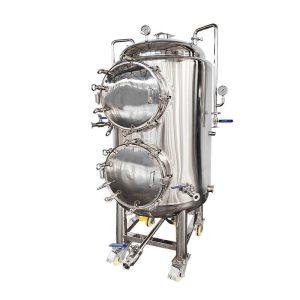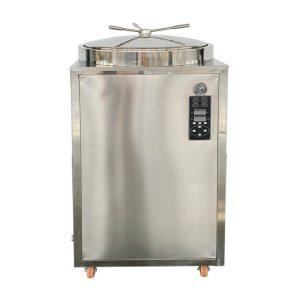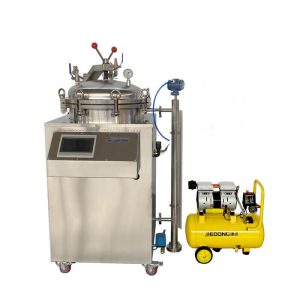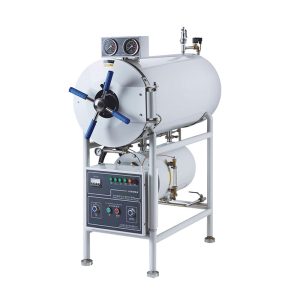- Loading the Objects: First, the items requiring sterilization are placed into the sterilization chamber of the high-pressure sterilizer. These can include medical instruments, laboratory equipment, food packaging, or other items needing a sterile treatment.
- Sealing the Chamber: Once the objects are in the chamber, the container is sealed to prevent any gas or steam from leaking out during the sterilization process. This sealing is essential to maintain the high-pressure and high-temperature conditions necessary for effective sterilization.
- Steam Injection: High-temperature, high-pressure steam is injected into the sterilization chamber. Typically, the steam temperature is maintained between 121°C and 134°C, and the high-pressure environment enhances the steam’s penetrating power, ensuring thorough sterilization by reaching all corners of the objects.
- Holding Period: After steam injection, a certain period is maintained. This time allows the high-temperature, high-pressure steam to eliminate microorganisms on the surface and within the objects, including bacteria, viruses, fungi, and spores.
- Steam Release and Cooling: At the end of the sterilization period, the steam is released, and the cooling system begins to operate. The items need to cool down to a safe temperature before they can be removed, now having achieved a sterile state.
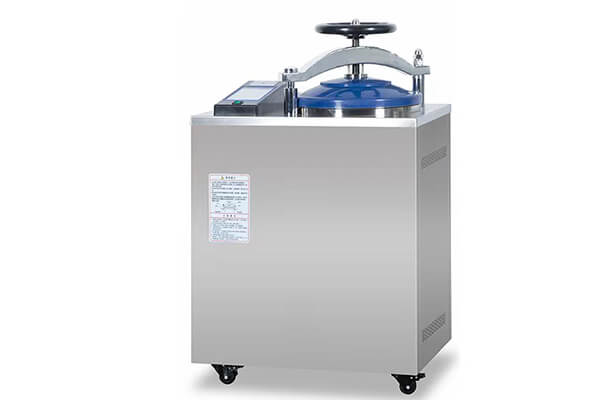
Autoclave
How long does an autoclave take to sterilize?
How does steam work in an autoclave?
- Steam Generation: Water is introduced into the autoclave’s heating chamber, where a heating element raises the water’s temperature, converting it into steam.
- Pressure Buildup: The autoclave is sealed tightly to prevent steam from escaping. As more steam is generated, it raises the pressure inside the autoclave. This combination of high pressure and elevated temperature is essential for effective sterilization.
- Sterilization: The high-pressure steam has excellent heat transfer capabilities. It permeates the objects being sterilized, increasing their internal temperature. This process efficiently destroys various microorganisms, including bacteria, viruses, fungi, and spores. The high-energy content of the steam ensures rapid, comprehensive sterilization.
- Holding Period: After sufficient exposure to high-pressure steam, a designated period is maintained. This ensures sustained sterilization, guaranteeing that all parts of the objects receive adequate heat treatment.
- Cooling: Once the sterilization duration is complete, the pressure is gradually released, and a cooling system kicks in to lower the autoclave’s internal temperature. This cooling phase ensures the sterilized items can be safely removed without causing any harm.
Why Autoclave is The Best Method of Sterilization
Autoclaving stands out as a highly effective method of sterilization for several reasons: 1.Comprehensive Microbial Elimination: Autoclaves use high-pressure steam, typically at temperatures above 121°C (250°F), which effectively destroys bacteria, viruses, fungi, and spores. This thoroughness ensures the elimination of a wide range of microorganisms, making it a reliable method
Why is autoclaving done for 15 minutes?
The reason high-pressure sterilization typically takes 15 minutes or more is to ensure the thorough elimination of various microorganisms, including bacteria, viruses, fungi, and spores. This duration has been determined through scientific research and experimentation and is driven by the following factors: 1.Sterilization Effectiveness: Different types of microorganisms have varying
How an Autoclave Works
The high-pressure sterilizer functions based on a fundamental principle that leverages elevated temperature and pressure to achieve potent disinfection. Here’s a simplified explanation of its workings: 1.Steam Generation: The sterilization process kicks off with the creation of steam. Water is introduced into a sealed chamber, where a heating element increases
How to clean autoclave monthly
Regularly cleaning and maintaining the high-pressure sterilizer each month is essential to ensure its proper functioning and effectiveness in disinfection. Here are the general steps and precautions for cleaning the high-pressure sterilizer: Power Off and Release Pressure: Before beginning the cleaning process, ensure that the high-pressure sterilizer is powered off
How Does an Autoclave Work
A high-pressure sterilizer operates by placing objects within a sealed chamber and introducing high-temperature, high-pressure steam. The working process can be summarized in the following steps: Loading the Objects: First, the items requiring sterilization are placed into the sterilization chamber of the high-pressure sterilizer. These can include medical instruments, laboratory
What is Autoclave Sterilization
High-pressure sterilization is a process that utilizes high-pressure steamand elevated temperatures to eliminate microorganisms on the surface and withinan object. In this procedure, the object is placed within a high-pressurechamber and subjected to high-temperature steam, typically within the range of121°C to 134°C. This high-pressure steam effectively penetrates the object,killing or

